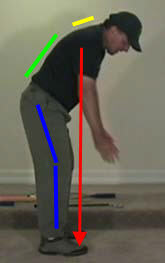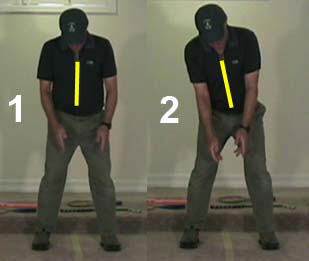Golf Master Tips, The body's pivot action is critical to a left arm swinger's action because it supplies the necessary swing power to release PA#4 (release the left arm).
I have described the pivot action in great detail in a number of my review papers and I will discuss certain important points in this review paper.
I increasingly believe that a fluid and complete pivot action is essential for a left arm swinger's action, and I increasingly believe that golfers should consider adopting an alternative swing style if they do not have the flexibility to complete the pivot action with great fluidity.
I demonstrate the pivot action in my swing video lesson. The following series of capture images demonstrates certain important points regarding the pivot action.
To perform this pivot action drill, a golfer needs to place a dowel stick, or golf club, behind his back - as demonstrated in image 1. Then, he should complete a backswing pivot action that will allow him to get the dowel stick to be perpendicular to the ball-target line - image 2.
It will require approximately a 45 degree pelvic rotation and a 90 degree upper torso rotation to get to this position. Then, a golfer should perform a downswing pivot action that continues to the finish position - image 3. At the finish position, the golfer should be standing erect with the pelvis square to the target and the right shoulder should be closer to the target than the left shoulder. During the downswing pivot action, the right shoulder must move downplane and move under the chin while the golfer retains his spine angle (avoids standing up).
It will require approximately a 45 degree pelvic rotation and a 90 degree upper torso rotation to get to this position. Then, a golfer should perform a downswing pivot action that continues to the finish position - image 3. At the finish position, the golfer should be standing erect with the pelvis square to the target and the right shoulder should be closer to the target than the left shoulder. During the downswing pivot action, the right shoulder must move downplane and move under the chin while the golfer retains his spine angle (avoids standing up).
The first requirement when assessing whether a golfer can perform the pivot action satisfactorily, is to assess whether a golfer has enough flexibility to completethe pivot action (from address => backswing => downswing => finish). However, that is not sufficient, because the pivot action must also be executed with great fluidity of motion.
If you look at my swing video lesson, you will note that I have insufficient flexibility to perform the complete pivot action fluidly. I have therfore failed the test, and I cannot expect to perform a left arm swinger's action well - because a fluidly-performed pivot action is an essential requirement. Golfers who lack the flexibility to perform the complete pivot action with great fluidity should consider alternative swing styles, which may result in better, and more consistent, ball contact.
If you look at my swing video lesson, you will note that I have insufficient flexibility to perform the complete pivot action fluidly. I have therfore failed the test, and I cannot expect to perform a left arm swinger's action well - because a fluidly-performed pivot action is an essential requirement. Golfers who lack the flexibility to perform the complete pivot action with great fluidity should consider alternative swing styles, which may result in better, and more consistent, ball contact.
Although I have described the pivot action in great detail in a number of my review papers, I am going to emphasize certain important points that I didn't fully discuss in those review papers.
Pivot Posture at Address
A golfer needs to have a suitable posture at address that will not only allow him to pivot his torso while remaining in balance throughout the entire pivot action - he must also have sufficient room under his chin for the swinging arms to swing freely in front of his rotating torso during the late downswing and followthrough.

Author demonstrating address posture - capture image from his swing video lesson
This capture image demonstrates a number of important postural features that a golfer needs to get right.
- There must be a small degree of knee flex (blue lines).
- A golfer must bend at the level of the hips, and not at the waist, which will result in a rounded back. To achieve that goal, a golfer must stick his butt-out so that his lower back can remain straight (green line) when he bends at the level of the hips. The "correct" amount of forward spinal bend is approximately 30 degrees - and a rough rule is that a straight line drawn down the back of the right arm vertically-down to the ground should pass just in front of the knee caps and hit the forefoot, or toes (red arrowed line). If the posture is correct, then the golfer's weight should be equally distributed between the balls of the feet and the heels. A golfer should "feel" like a football quarter-back who is ready to receive a ball that is going to be thrown from a huddle setup.
- The upper back should be rounded (yellow line) so that the golfer can look straight down at the ball, without having to flex the neck.
- The upper arms should hang vertically down from the shoulder sockets, and the hands should be under the chin (for a driver) and closer to the thighs (for a short iron).
Consider another aspect of body posture that is best viewed from a face-on view - spinal/upper torso tilt.

Author demonstrating rightwards spinal tilt at address
Why does a golfer need rightwards spinal tilt at address? A golfer needs to have rightwards spinal tilt at address for two major reasons - i) the right hand is lower on the grip than the left hand by "X" inches and the right shoulder must be lower than the left shoulder at address by roughly the same "X" amount of inches; and ii) a a golfer needs to pivot around a rightwards tilted spine to acquire the "correct" reverse-K postural alignment at the end-backswing position - without indulging in any lateral swaying of the upper torso.
I have recently changed my recommendations for achieving the "correct" amount of rightwards spinal tilt at address (image 2).
Consider image 1 - note that I am standing in a tripod-fashion with my weight equally distributed between the left foot and right foot, with a straight spine (yellow line) and my head centralised between my feet. There are two ways to acquire rightwards spinal tilt from that centralised tripod posture.
- A golfer could keep the pelvis centralised between the feet and simply tilt the upper torso to the right (away from the target). That will produce rightwards spinal tilt and it will cause the head to move slightly rightwards (so that is behind the center of the stance).
- A golfer could shift the pelvis slightly to the left while keeping the head relatively centralised. If the pelvis moves slightly leftwards, it will cause the lower lumbar spine to move leftwards. If the head is kept relatively stationary in the center of the stance, then a golfer will have acquired rightwards spinal tilt - image 2.
I now favor the second approach of acquiring a small degree of rightwards spinal tilt at address. The major reason for favoring this approach is that it "feels" like the left leg is already braced at address - if the pelvis is shifted to the left at address.
I think that swinging against a braced left side in the downswing, without having a problem of excessive left-lateral pelvic slide during the downswing, is very useful and I think that adopting a braced left pelvis/leg at address is useful from this perspective.
I also think that it is better for a golfer to keep the head relatively centralised between the feet at address, and I believe that a golfer should also attempt to keep the head relatively stationary in that same relatively-centralised position throughout the backswing and downswing.
If a golfer adopts approach number 1, and acquires rightwards spinal tilt by tilting the upper torso away from the target while keeping the pelvis centralised, it causes the head to move back too far back behind the center of the stance. This head-position may predispose to "hanging back" on the downswing.
I think that swinging against a braced left side in the downswing, without having a problem of excessive left-lateral pelvic slide during the downswing, is very useful and I think that adopting a braced left pelvis/leg at address is useful from this perspective.
I also think that it is better for a golfer to keep the head relatively centralised between the feet at address, and I believe that a golfer should also attempt to keep the head relatively stationary in that same relatively-centralised position throughout the backswing and downswing.
If a golfer adopts approach number 1, and acquires rightwards spinal tilt by tilting the upper torso away from the target while keeping the pelvis centralised, it causes the head to move back too far back behind the center of the stance. This head-position may predispose to "hanging back" on the downswing.
Each individual golfer can experiment with these two optional approaches in order to discover which approach works better for him. (Source)


0 komentar:
Post a Comment